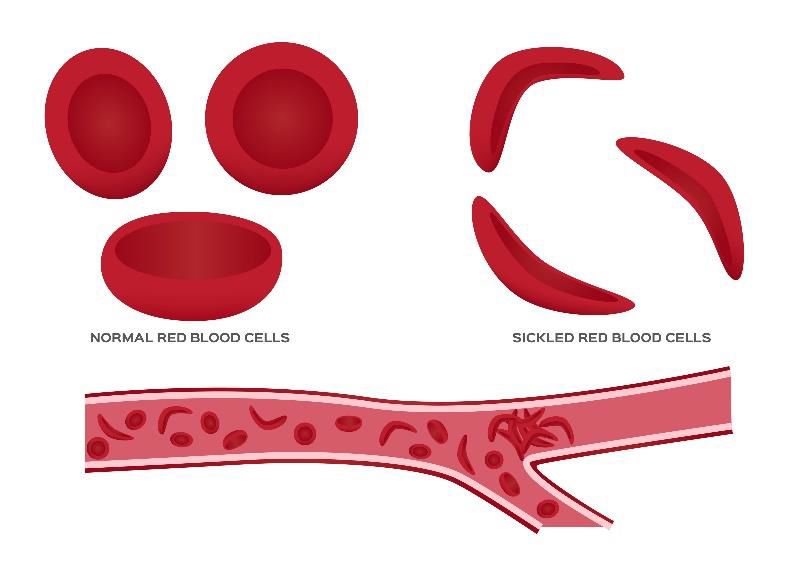Sickle Cell Disease Sickle Cell Disease
- Isala
- Patiëntenfolders
- 8319 Sickle Cell Disease
Information for parents and their children with Sickle Cell Disease
Sickle Cell Disease is a chronic blood disorder that affects red blood cells. Red blood cells are oxygen carriers. Oxygen is essential for the body to function. A typical red blood cell is round and flexible, which allows it to flow through small blood vessels reaching all parts of the body.
In Sickle Cell Disease, some of the red blood cells become hard and sticky and look like a C-shaped farm tool, a crescent shape, so called “sickle”. These abnormally shaped red blood cells break apart easily and get stuck to the blood vessel wall, blocking blood flow. This can cause episodes of severe pain, organ damage and other health issues such as infections.

What causes Sickle Cell Disease?
Sickle Cell Disease is a genetic disorder that causes anemia. That means it is an inherited trait, just like hair and eye colour. A person with the disease is born with it. Sickle Cell Disease is not contagious; therefore, you cannot “catch” the disease from being around a person who has it.
Who has it?
Sickle Cell Disease affects millions of people throughout the world. It affects mostly people whose ancestors originate from Africa, the Caribbean, the Mediterranean, the Middle East and Asia, including India, Pakistan, Bangladesh and South East Asia. In the Netherlands each year 40-60 children with Sickle Cell Disease are born. When the child is born with this disease, it is not sick. Only at the age of 4-6months, it can experience the first symptoms.
Complaints and symptoms
What are the first complaints and symptoms of Sickle Cell Disease in children?
- Painful swelling of the hands and feet
- Looking pale (pale skin)
- Distended painful abdomen
- Infections which are not self-limiting
What can you do?
What can you do about these complaints and symptoms?
- Warmth - Taking a warm bath can relieve the pain. Placing a heat pack or warm, moist cloth on the painful place can also help.
- Clothing- Wear warm clothing when it is cold outside. Use gloves to protect your hands. Wear wide comfortable clothing without elastics.
- Drinking lots of fluids- This prevents the sickled cells from clumping together and helps to keep them from getting clogged up in small blood vessels.
- Light physical exercise & play quietly - you can do sports and play, but without too much physical exertion.
- Massage- Gentle massaging of an arm, leg or back can relax the child and stimulate the blood circulation.
- Pain control - Pain medication administered according to a fixed schedule is extremely important to guarantee the most effective pain relief.
- Follow routine treatments to avoid infections (including vaccination)
What is a Sickle cell crisis?
The disease can cause so called “sickle cell crises”, a pain crisis during which the affected children are experiencing severe pain. Most of the time you can treat this pain crisis at home with adequate painkillers, but some children have to be admitted to the hospital to receive stronger painkillers and plenty of fluids. Some children are experiencing more painful crises than others, this is unpredictable. Because Sickle Cell Diseases only becomes noticeable at the age of 4 to 6 months, a baby cannot experience a painful crisis as described above.
Risk factors for a painful crisis – so try to avoid:
- Exposure to cold temperatures or exposure to excessive heat
- Tight clothing
- Dehydration
- Strenuous physical activity
- Other infections
- Stress
- Growth spurt and puberty during adolescence (impossible to avoid)
Treatment
Treatment of children with Sickle Cell Disease
The complaints and symptoms of Sickle Cell Disease are generally treated with painkillers, additional fluids and antibiotics. Children with Sickle Cell Disease have a higher risk for infections, because the spleen, the organ that normally filters out damaged blood cells and helps fighting infections, is not functioning as well as it should be in children with Sickle Cell Disease. Due to unnoticed sickling (clumping together of the blood cells) in the spleen, scarring occurs in this organ. In order to prevent infections several measurements are taken in all children with Sickle Cell Disease:
- Vaccinations
In order to prevent bacterial infections, all children with Sickle Cell Disease are vaccinated against:
- Pneumococcus
- Haemophilus influenza B (HiB)
- Meningococcus
- Medicines
- Antibiotics – Patients with sickle cell disease need to use antibiotics daily to prevent bacterial infections o Folic Acid – type of vitamin B to support red blood cell production
- Pain killers – Paracetamol or Ibuprofen to control the pain, discuss the right dose with your doctor
- Blood transfusions
In case the number of red blood cells in the blood are getting too low, children need a blood transfusion, which is done in the hospital.
More information
- For more information about Sickle Cell Disease go to the website 'About kids health'.
- Patient organization OSCAR: Organisation for Sickle Cell Anemia Relief (www.sikkelcel.nl)
- The Sickle Cell Podcast - Talking about all things sickle cell related (on Spotify for example)
When to contact?
When to contact a health care provider?
- Pain that does not react to treatment at home
- Any fever (temperature above 38C)
- Respiratory problems (cough, difficulty breathing, chest pain)
- Dehydration (dark, infrequent urine)
- Severe abdominal pain
- Diarrhea/vomiting and inability to drink
- Swelling and redness in an arm, leg or back
- Sudden, severe headache
- Signs or symptoms of stroke: One -sided paralysis or weakness in the face, arms or legs; confusion; trouble walking or talking; sudden vision problems or unexplained numbness; or a headache, call your local emergency number right away
Contact
If you have any questions, please call the location where you are being treated:
Zwolle, Meppel or Steenwijk
Pediatrics
088 624 50 50 (available from Monday to Friday from 8.30 a.m. to 5 p.m.)
